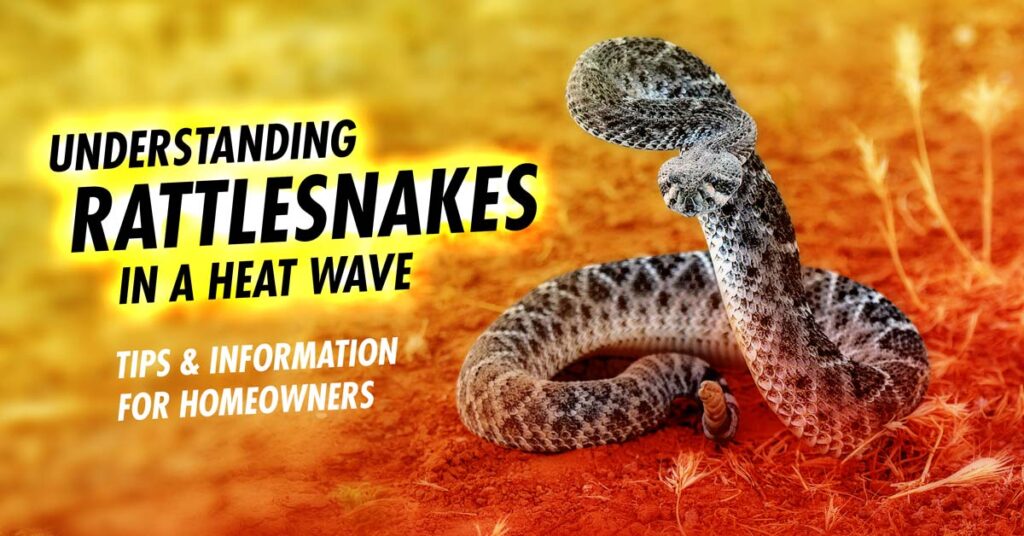
Each day in July, 2023 has been above 110˚F with no end in sight. What do the rattlesnakes do?
A common misconception is that reptiles love the sun – the hotter, the better, right? Well, not quite. Like all reptiles, rattlesnakes are ectotherms and get their heat from the environment. But that doesn’t mean they don’t have limits. Just like you in the office when whats-his-name down the row keeps fiddling with the thermostat, rattlesnakes prefer specific temperatures. And more importantly, they can quickly die when they get too hot.
How hot is too hot for a rattlesnake? It depends. Generally, if the body temperature gets above 110˚ for even a little while, a rattlesnake will not survive. With ground temperatures hot enough to cook an egg, a rattlesnake caught out in the open for even a minute mid-day in Arizona will not survive. Aside from overheating, prolonged heat can kill off rattlesnakes by desiccation, literally drying out in the Arizona oven while the monsoon takes its sweet time getting here.
Where do rattlesnakes go when so hot?
Rattlesnakes hide away during the hottest and driest time of year in carefully selected retreats in a behavioral state known as aestivation. Think of it as hibernation to escape the heat instead of cold. Each year, rattlesnakes may use the same aestivation den, alongside other rattlesnakes of multiple species. And just like hibernation, these aestivation dens serve as social hubs, as well as survival escapes.
In the wild, these aestivation dens may be a cave in a drainage wall, a deep crevice in a rocky outcrop, packrat nests, or any number of other deep, thermally protected areas. But near developed areas, an even greater resource exists: backyards.
Openings to the foundation, cracks in the concrete leading under the deck, the shaded base pad under pool pump equipment, and more can be ideal aestivation dens for groups of rattlesnakes. Even better, almost all backyards provide easy sources of water. Combine all of this with dense, well-watered lantana or rosemary, and the perfect rattlesnake summer sanctuary is made.
If you find a rattlesnake in the yard right now, it’s possible it has been there awhile.
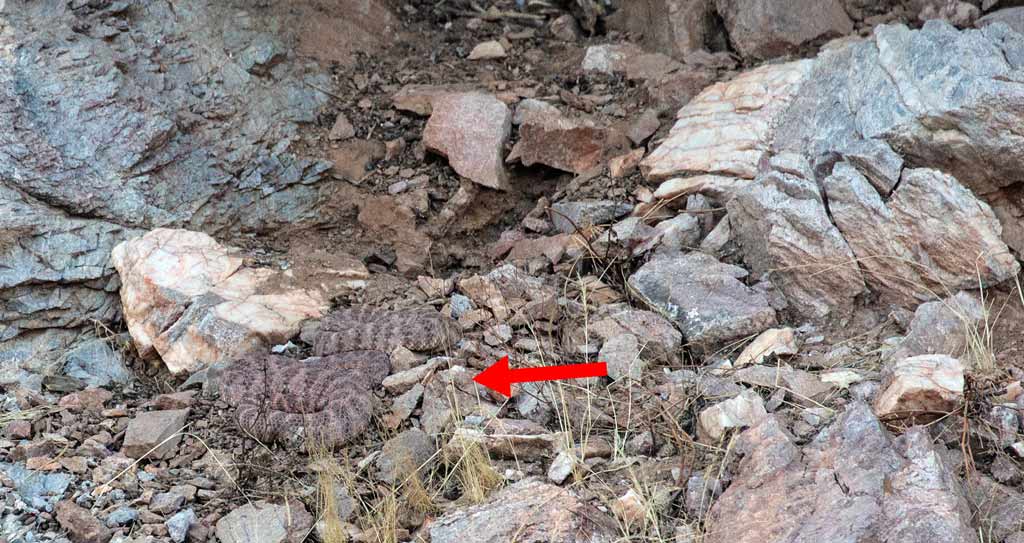
These Speckled Rattlesnakes are resting a short distance from their aestivation den and will retreat once the sun heats the area. This is a similar situation to aestivation dens found at homes, where homeowners may encounter them on the patio a short distance from the actual den.
“But it’s a dry heat”
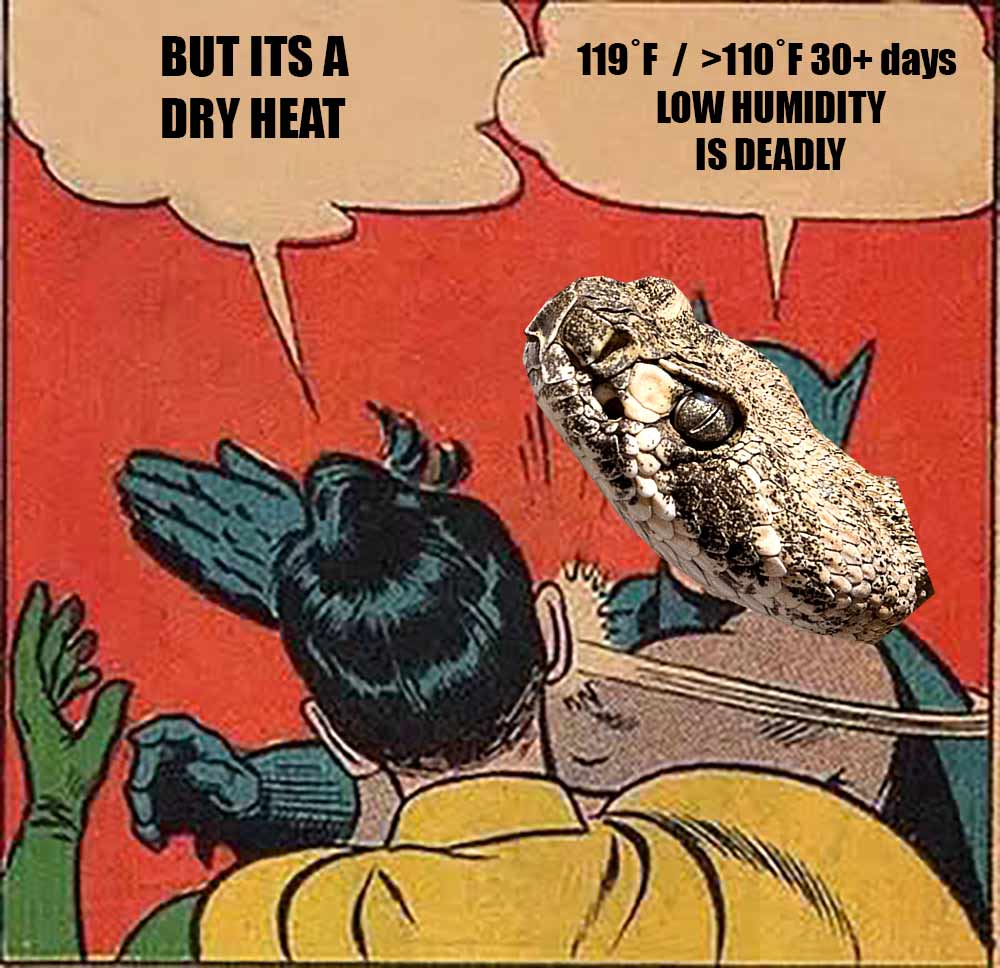
Don’t be fooled by this favorite statement of visitors from wetter climates. We’re not talking about feeling sweaty and uncomfortable while you eat BBQ – dry heat kills.
Moisture loss is a significant danger to rattlesnakes when it’s so hot and dry outside. Simply breathing is dangerous, as every molecule of water lost from the body won’t be replaced until it falls from the sky. Any source of sustained water can and will attract rattlesnakes and other wildlife. If there is deep cover nearby to wait out the day until the next opportunity to drink, it makes an irresistible resource.
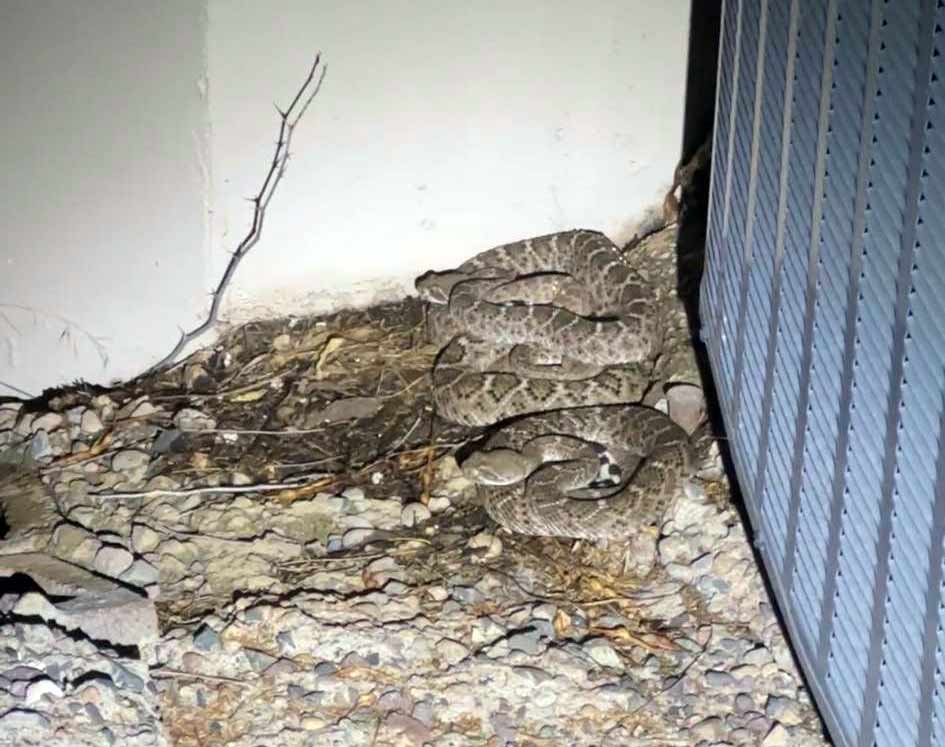
For homeowners, now is the time to review the property. Something as simple as a dripping hose or irrigation line that’s a bit too generous may be an oasis bringing venomous snakes to the yard. Eliminate any sources of water possible. View the property as critical habitat, and make careful decisions. If a rattlesnake is spotted few times a year near that over-watered natal plum, it’s time for some hard decisions about that plant.
What happens to rattlesnakes that are relocated when it’s so hot?
This statement doesn’t exactly make us popular, but it’s the truth. Do not call the fire department or the local security guard to relocate snakes, especially when it’s this hot. Even if the fact the snake will likely die isn’t reason enough, a potentially more dangerous situation can be the result. It doesn’t matter who: call a professional with deep snake knowledge. Here is why:
Homeowners are finding rattlesnakes in entryways or in a corner along the back patio and calling for relocation. The trick is, however, that these situations are usually not new. If a rattlesnake is in a yard right now, there are two scenarios that are most likely:
- The rattlesnake has been aestivating on the property or immediately adjacent and is being discovered by chance after weeks of undetected behavior.
- The rattlesnake was displaced by construction. Or, with increased frequency, botched relocation by the fire department or under-experienced relocator.
Rattlesnakes are often found in small groups aestivating in backyards. When we are called to catch one, we can usually locate the aestivation den, where we look to see if there are more. The homeowner is then educated on what is happening, and how the den can be addressed to prevent future, similar encounters. In these instances, the snake itself is not the issue, but a symptom of a provided resource. Usually, these can be fixed relatively easily.
Rattlesnake encounters in the summer that are due to construction of unexperienced relocation are a more complicated matter, unfortunately. While it is a great thing that there is an increased will out there to not kill rattlesnakes and have them relocated instead, the details matter greatly. If a rattlesnake is captured by the fire department and moved to a nearby bush or released to open ground, one of two things happen: the snake dies, or it panics and manages to escape to the nearest cover. This can be shade at the neighbors’ house, back to the original location, or any number of potentially dangerous situations. Rattlesnakes that are able to behave naturally can often coexist for a lifetime without conflict with humans by careful evasion, but all bets are off when they are forced into a cover-or-die situation.
We are currently seeing a lot of activity on our snake removal hotline. Rattlesnakes and other wildlife are having a tough time in this heat, forcing them to take desperate measures to survive. This increase of conflict is something that can be resolved by working with the natural behavior of the snake. This means that snakes that are captured for relocation must be released directly into a suitable replacement aestivation den. This also means that the individual relocating the snake needs to be able to identify aestivation microhabitat.
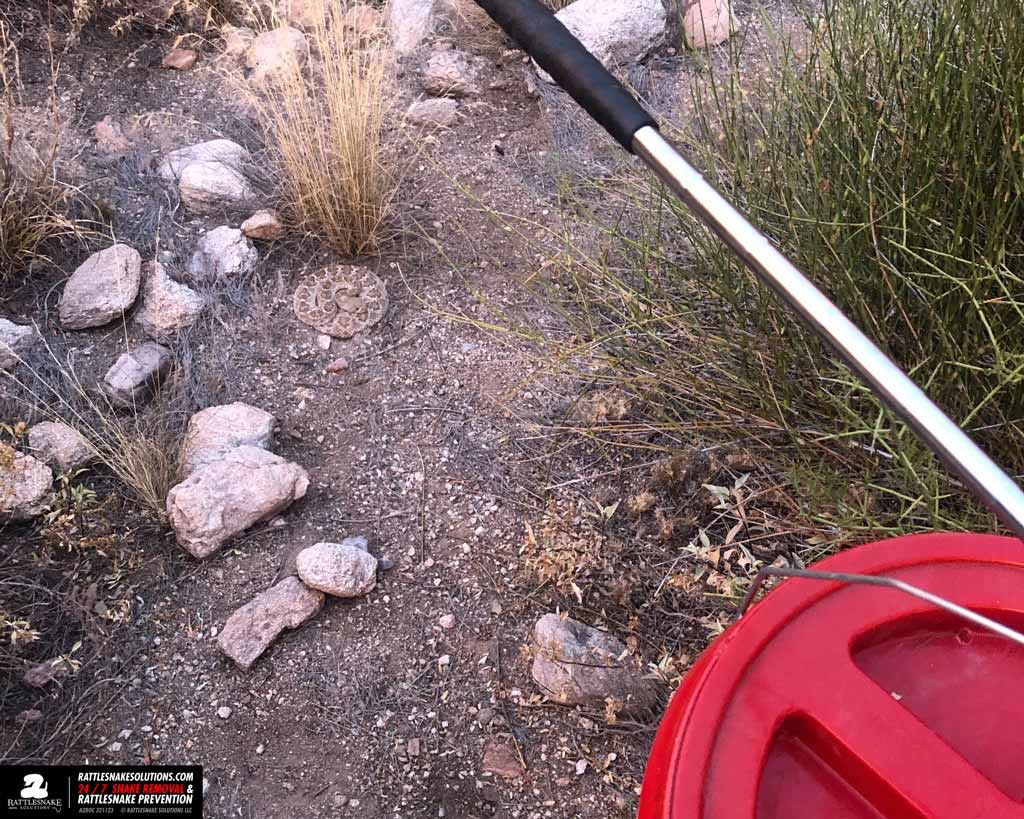
This Western Diamondback Rattlesnake was found by a snake relocator while searching for a suitable aestivation den to relocate a rattlesnake found at a home. This snake is a clue that the right release site is nearby. This careful release site selection is essential during the summer.
How to keep rattlesnakes out of the yard during the summer
The best way to keep snakes out of the yard during the hot, dry summer months is to reduce critical resources as much as possible. When it is this hot, rattlesnakes aren’t traveling around like they would be during the spring and fall, so the situations where they are found. This means rattlesnake encounters at homes are much more predictable and, therefore, avoidable.
Here are some things that can be done in a single weekend that can significantly reduce the chances of a summer rattlesnake den in the yard:
- Do a sweep of the property for unnecessary water sources. This means fixing the leaky hose, cleaning up the outdoor dog bowl area, and checking on landscaping irrigation and drip lines to make sure they’re in good shape.
- Watch areas of AC condenser run-off. You may be able to fix these situations by placing a metal can under them to prevent the ground from getting wet, and allow faster evaporation.
- It’s time to get rid of those overgrown, over-watered lantana and rosemary bushes. They come standard with every home in Arizona, but consider native plants that require less water and are less likely to attract rattlesnakes and their prey.
- Look into snake fencing as an option to physically prevent entry.
- Find and fill any cracks and openings to the foundation of the home and other buildings. Any access to crawl spaces, flashing, under pavement and the driveway, or the foundation can become rattlesnake dens in the summer.
- Carefully check seldom-visited sections of the yard: specifically pool pump areas and air conditioning units. These spots are usually hidden away and provide easy, private retreats for rattlesnakes and other animals.
- Flood and destroy rodent burrows as they are found.
By this time, when rattlesnakes have already been at their summer retreats for several weeks, it’s more productive to prepare for what comes next: the monsoon activity, where encounters will be at the highest rate of the year.
For more information about how you can make your yard less rattlesnake friendly, take a look at our guide to keeping rattlesnakes away.
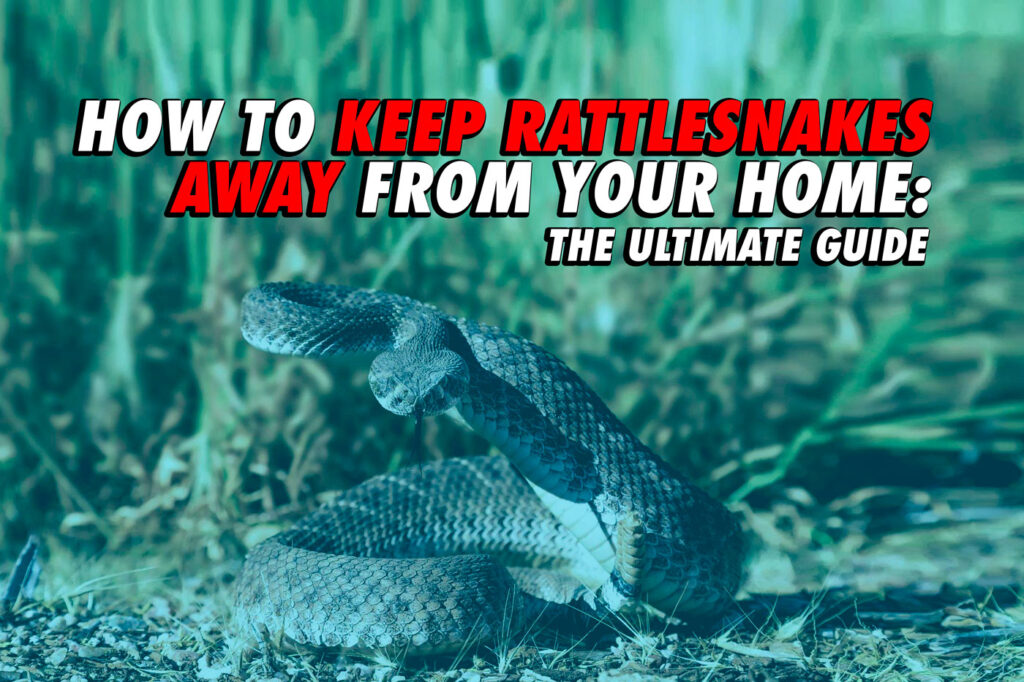
What happens to rattlesnakes when the monsoon comes?
Once the monsoon rain comes, several events are kicked off.
First, the abundant ambient moisture and access to water relieve some of the survival pressure. Rattlesnakes will no longer be forced to hide away, meaning they can resume moving, hunting, and other activities. Rattlesnakes encountered in backyards will be less likely to be long-term residents. Aestivation dens are largely abandoned for the year for many species.
Often this is when rattlesnakes shed their skins, too. The moisture can start the shedding process, during which many rattlesnakes remain hidden away for a period of time, regardless of the nicer conditions outside. However, once they shed, they’re off to hunt and more.
Next, it’s time for babies! The moisture kicks off the birthing season. Rattlesnakes either birth in place, or move to special places where babies will be born, called rookeries. Depending on the species, the timing and location of this event varies. For Western Diamondback Rattlesnakes, which make up the bulk of rattlesnake encounters with homeowners, this can be about anywhere with adequate cover.
Questions and Answers about Summer Rattlesnake Activity:
Can I use a garden hose to move a rattlesnake away while it’s this hot?
You can, but it is likely a temporary solution. Rattlesnakes found in the yard right now are likely aestivating nearby, and will remain in the area until they can leave after the monsoon rain brings relief. Also, make sure the water isn’t too hot by spraying it to the side for a few seconds.
Are rattlesnakes more likely to be found indoors during this time?
Yes, but it’s still a very remote possibility. Even though indoors is obviously cooler, very few rattlesnake removal calls are inside homes during this time of year. The majority of rattlesnake in-home calls we respond to are due to doors being left open in the Spring and Fall, which is not an issue when it is above 110˚F outside.
Do rattlesnakes climb trees and shrubs to get away from the hot ground?
Rattlesnakes are often found up off the ground in bushes outside of their aestivation dens when it is this hot outside. A bit of airflow can help a snake keep cool, and they seem to take advantage of it.
How often do we find rattlesnakes that have died from the heat?
In our research of rattlesnakes living in urban islands, it is not uncommon to find rattlesnakes that have died during the hot and dry foresummer. This can be exacerbated by disturbance, such as stress from visitation or poorly performed relocation. An event as simple as a short delay from overnight location back to the den can mean death.
Am I attracting rattlesnakes if I provide water for generally preferable wildlife, such as rabbits and birds?
If this is being done in an area where rattlesnakes can occur: absolutely. Not only by providing water, but attracting prey animals as well. If there’s also an area the rattlesnakes can escape to during the day, it’s an ideal rattlesnake situation.
Where do wild rattlesnakes find water during the heat?
For the most part, they don’t. They are forced into a state of preservation, waiting for the monsoon rain to come. Others may find water at springs, rivers and streams, cattle tanks, and other sources of year-round water. But for many rattlesnakes, this simply isn’t an option.
Can excessive heat cause negatively affect the reproductive success of rattlesnakes?
Yes. Conditions of prolonged heat and drought are difficult to survive for any age of rattlesnake, with newborns being especially susceptible. In the summer of 2020, during a long period without rain and excessive heat, we observed that speckled rattlesnakes more often gave birth at aestivation dens rather than move to typical locations. This was mirrored in birthing events of Western Diamondback Rattlesnakes and others, giving birth in less-than-ideal situations. While these effects aren’t well documented, our observations and anecdotal experience with birthing in urban situations show, essentially: panic.
What do rattlesnakes do on hot ground or pavement when it’s this hot outside?
They die. This is why it is avoided at all costs, and it’s lethal to them when the fire department dumps them into a bush rather than relocate to a suitable area.
Are there any repellents that can be used to keep rattlesnakes from spending the summer in my cooler, wetter backyard?
Unfortunately there are no snake repellents on the market that will keep snakes of any species away, despite claims. The effective alternatives are a combination of habitat and resource reduction and, where applicable, snake fence installation.
Do rattlesnakes mate when it’s this hot?
Rattlesnakes can court and mate at any time of year, but typically the seasons for doing so are in the spring and fall, depending on species.
Is it ok to leave water our for rattlesnakes and other wildlife?
Yes it is! Just be sure that it is clean and does not become a disease vector. Also understand that doing so will indiscriminately invite wildlife to the area, and it’s not possible to pick and choose. Leaving water out for birds and bunnies is the same as doing so for rattlesnakes.
Are there specific scents or chemicals that can be applied to deter rattlesnakes? How about plants?
There are currently no products, operating either by scent or otherwise, that will effectively deter rattlesnakes and would be legally and ethically feasible.
The rumors about plants such as rosemary, lemongrass, mint, and other “snake-repellent” plants are just local mythology. Ironically, some of these, such as rosemary, provide deep ground cover that can actually attract rattlesnakes.
Does the application of lava rock, gravel or other small rocks deter rattlesnakes?
While these materials do not directly deter rattlesnakes, they may provide some protection in some areas simply by being hot ground cover. However, using these materials specifically for rattlesnake deterrent purposes would not be advisable. Remember that rattlesnakes live in very hot, rough environments. Using rocks, even sharp rocks like lava rock, would not have an effect.
How often do rattlesnakes need to drink?
If given an opportunity, they can drink every day. However, they are very efficient and many ways of preserving moisture through their behavior and physiology, and can go for several months without a drink if they must.
What can I do to help the rattlesnakes without causing unintended danger (to either them or me)?
This may seem like a non-answer, but simply having the attitude that rattlesnakes should be kept alive and are important wildlife is an important node contributing to changing culture. Perhaps the best thing someone can do, if they are aware of the potential risks associated and are able and willing to communicate as needed to visitors and others, is to simply leave the rattlesnakes in place.
At my own home, for example, we have discovered an aestivation den of Western Diamondback Rattlesnakes hiding out under the AC unit behind the house. It’s not in an area with immediate concern, but we know it’s there and make sure we behave appropriately. Rather than relocate these, we will allow them to stay there for the remainder of the aestivation period, then will likely repair the leaky AC drip that has caused the situation. We know there are several nearby and suitable aestivation sites in the immediate area, so loss of this one will not have negative consequences for these snakes.
